Trauma Surgery in Early Modern Europe
- 1. Trauma Surgery in Early Modern Europe Scott Moore For Beau Monde & Hearts through History July 30, 2008
- 2. What to expect Tips on researching medical history 330 years in 45min 1500 ŌĆō 1830 Europe only Trauma surgery only NC-17 descriptions Woundman, from Hans von Gersdorff, Feldtbuch der Wundartzney , 1517.
- 3. Tips on Researching Medicine Context matters ŌĆō who is writing and why PAST = medical professionals writing history for others medical professionals => ŌĆ£modernŌĆØ view and jargon, bias, focus on discovery and lone genius, national pride TODAY = Social History of Medicine => contemporary view and language, patient view, ignored voices, less linear view of innovation
- 4. Medical innovation was not monolithic or homogenous 16thC 17thC 18thC 19thC England, Scotland Barber-surgeon guilds ŌĆō limited knowledge Harvey and circulation, but not accepted Political instability lead to isolation 1599 ŌĆō James VI granted charter for faculty of physicians and surgeons in Glasgow London physicians and surgeons become unregulated Education shift from guilds to private schools and new hospitals in London Small pox vaccination developed Glasgow develops as significant center of medical education Better communication between nations leads to transnational influences in advances in anesthesia, antisepsis and cellular pathology. These advances radically change surgical possibilities. (For example, Lister, who developed antisepsis was influenced by the French Pasteur and then carried his ideas to America.) France Medical schools and hospital (H├┤tel Dieu) in Paris, Ambroise Par├®, innovator Par├®ŌĆÖs innovation not widely accepted Intense fighting between barbers and surgeons stifles innovation Surgeons gain political and professional status with university training mandatory before surgical apprenticeship until revolution abolishes guilds and medical societies. Paris becomes center for surgical education Italy Some university training for surgeons in Pavia, Padua, Bologna More medical schools open in Pisa and Naples, but surgery is generally unorganized. Some experimentation with kidney stone surgery Surgical training remains unorganized. Napoleonic conquest and division further stifles advances. German speaking lands No unified surgeon guilds 30 Years War devastates country. Prior to war, Fabry von Hilden taught in Basel and after war Johannes Scultetus published surgical works. Formal education fails to take hold in Austria. Prussia establishes military surgery school in Berlin. Generally, suspicion, superstition, poor training, and competition with other trades stifles surgical advances. Others Spain: no significant contributions to European surgery Netherlands: Leyden and Amsterdam rise as significant centers of medical education Netherlands: Clinical teaching of medicine and advances in anatomy USA: lack of established healers means fewer divisions between surgeons, physicians and apothecaries
- 5. Finding Credible Sources Second source material by modern historians ŌĆō overviews, context, details on procedures, names and titles of primary sources. Journals of the history of medicine ŌĆō sources from manuscripts, letters, court or civil docs; book lists and peer reviews. Primary source material in the form of surgical texts ŌĆō These are the most easily obtainable through reproductions and modern translations. A caveat for in-period translations is to be aware that the translator may change text or images to reflect their point of view. If you can find modern translations of period texts, check for journal book reviews, and use them.
- 6. Misunderstandings and Myths 1785 etching by Thomas Rowlandson from Orthopedic Surgery Residency Program at The George Washington University Medical Center. http://www.gwumc.edu/edu/ortho/
- 7. Education of surgeons Myth ŌĆō Surgeons were professionals with similar education as physicians. Reality ŌĆō Surgery was a trade dealing with the physical aspects of the human body. Myth ŌĆō Surgeons were ignorant quacks who were more a danger than a help Reality ŌĆō Ignorant healers existed and flourished, but trained and licensed surgeons sought to avoid unnecessary harm and better understand the human body.
- 8. Alcohol as anesthesia Myth ŌĆō patient should be drunk before cutting begins Reality ŌĆō Perhaps a small glass of wine before and after, but not to drunkenness. J. D. WHITBY (1980) Alcohol in anaesthesia and surgical resuscitation Anaesthesia 35 (5) , 502ŌĆō505
- 9. Prohibitions against dissection Myth ŌĆō The catholic church forbade dissection of the human body and this lead to underhanded methods of obtaining bodies.
- 10. Reality ŌĆō Papal bull issued at the turn of the 14thC prohibited crusaders from reducing Christians to bones for shipping home. Did not eliminate dissection, but may have had a chilling effect. Competition of 18 th /19 th C anatomy schools lead to shortages => grave robbing and murder. Dissection Scene from Fasciculo di Medicina , Johanned de Ketham, 1496. Nuland, Sherwin. Medicine: the Art of Healing.
- 11. Amputations Myth ŌĆō Surgeons amputated at the drop of a hat Reality ŌĆō Before mid-19thC surgeons focused on healing the wound and used amputation as a last resort if the wound failed to heal and threatened the life of the patient or if the bones were so shattered that they would not allow a clean healing stump.
- 12. Hollywood Amputations Myth ŌĆō Saw through the whole limb Reality ŌĆō No one *ever* sawed through flesh.
- 13. How to Perform an Amputation 1. Compress the limb to slow/stop blood flow Petit Tourniquet c1820, Bennion, Elizabeth. Antique Medical Instruments . 16 th C ŌĆō hands, tight wrapped linen, 17 th C ŌĆō single band twisted with rod 18 th C ŌĆō Petit then clamp tourniquets
- 14. How to Perform an Amputation 2. Slice through the flesh with a knife around the limb and down to the bone Detail of Leg Amputation, artist unknown, mid-18 th C. Carmichael and Ratzan. Medicine: A Treasury of Art and Literature.
- 15. How to Perform an Amputation 3. Retract the flesh toward the body to expose the bone Charles Bell's Illustrations of the great operations of surgery, 1821. University of Iowa Libraries. John Martin Rare Book Room http://www.lib.uiowa.edu/hardin/rbr/Imaging/albums/bellsurg/index.html
- 16. How to Perform an Amputation 4. Saw through the bone Amputation saw. c16thC ~24 in. Germanisches National Museum N├╝rnberg. http://www.bildindex.de
- 17. How to Perform an Amputation 5. Release the retraction and staunch bleeding 6. Release compression to find missed blood vessels 7. Bandage and attend to healing Cauteries, c.1750. ~12 in. Bennion.
- 18. General wound care and recovery from surgery The course of illness was not often dramatically altered or shortened or terminatedŌĆ” surgery entailed weeks of daily wound care rather than dramatic interventions that characterize modern operative surgery. - Mary E. Fissel Bulletin of the History of Medicine, Spring 2008 V82no1, page 14.
- 19. Treating wounds Deep wounds were often kept open to allow draining and prevent abscesses. If muscles or tendons cut across grain, some recommended sutures. Others recommended contracting and immobilizing muscles. If in line, no sutures. Styptics were also used to control bleeding though sometimes misapplied. Bleeding a blood vessel above the wound was very common.
- 20. Many styles of sutures Adhesive cloth and suture for facial cuts. Ambroise Pare. Three and Fifty Instruments of Chirurgery. 1631. Sample sutures, ca 18thC Medizinhistorisches Museum of the University of Zurich http://www.mhiz.unizh.ch/ Hannah Blair, Photographer http://www.flickr.com/photos/hannahmae/ [Various types of suture techniques and instruments] / J.M.B. sc. 1734 Images from the History of Medicine at the U.S. National Library of Medicine http://wwwihm.nlm.nih.gov
- 21. Healing By First Intent ŌĆō Nothing introduced to wound. Bandages moistened with various liquids. By Second Intent ŌĆō salves or oils of all kinds are put in wound. Became more complicated as time progressed.
- 22. INFECTION! ŌĆ£ SuppurationŌĆØ was the term used more often by this time than ŌĆ£laudable pusŌĆØ. It was often induced as part of the healing process. About the mid-18 th C there were some reporting better success at healing when suppuration was avoided.
- 23. ŌĆ£ weeks of daily wound careŌĆØ Complications seem to have been the norm. Wounds can spontaneously reissue blood and abscesses can form once the wound can closed. These will be treated as new wounds, usually with bleeding and a change of bandage (to reintroduce styptics). Abscesses will likely be drained with a scalpel.
- 24. How to Remove Arrows and Gunshot Many similarities so combined steps: 1. If missile can be felt under skin, cut down to it and remove it.
- 25. How to Remove Arrows and Gunshot 2. If the missile is deep, enlarge the entry wound by cutting. You may use a dilator: Dilator Hans von Gersdorff Feldtbuch der Wundartzney , 1517. Dilators, 16thC, ~10in. Germanisches National Museum N├╝rnberg. http://www.bildindex.de
- 26. How to Remove Arrows and Gunshot Special note about arrows ŌĆō Yeowch! Arrow heads for war, bodkins for armor and swallowtails for hunting. The Battle of Shrewsbury, http://www.militaryhistoryonline.com/
- 27. How to Remove Arrows and Gunshot 3. For arrows, protect the barbs, by covering or bending. For gunshot, fingers and forceps will do: Arrow and shot forceps. 16 th C Germanisches National Museum Scott Moore, Photographer
- 28. How to Remove Arrows and Gunshot Ball screws are described throughout early modern period, but seem to have been used mainly if the gunshot was lodged against bone. These are more finely made than the picture shows. Bullet extractor c1520 ~12 in. Germanisches National Museum N├╝rnberg. http://www.bildindex.de
- 29. How to Remove Arrows and Gunshot 4. Treat the resulting wound(s) as any other wound. In the 16 th /17 th C, it was popular to cauterize gunshot with hot oil, caustics or cauteries. In addition to holes, gunshot can also cause fractures.
- 30. How to Treat a Broken Limb Diagnose the degree and location of the fracture. If a compound fracture, treat the wounds as before. Amputation is likely if the healing does not go well.
- 31. How to Treat a Broken Limb Extend the limb so the bone(s) may be fitted together.
- 32. How to Treat a Broken Limb Bind the limb tightly. [Fractured arm and Simple fracture] / Arnold Delineavit. 1666 in Armamentarium chirurgicum by Johannes Scultetus Images from the History of Medicine at the U.S. National Library of Medicine http://wwwihm.nlm.nih.gov
- 33. How to Treat Dislocations Start before inflammation starts, wait until is subsides, or draw blood. Put the joint back in place (reduction) usually with some form of leverage device. Prevent the limb from moving until healed. Scultetus' Armamentarium chirurgicum, table 23. 1655 University of Iowa Libraries. John Martin Rare Book Room http://www.lib.uiowa.edu/hardin/rbr/Imaging/albums/bellsurg/index.html
- 34. How to Treat a Skull Fracture
- 35. How to Treat a Skull Fracture Check the fracture to see if the skull depresses inward and if bits of skull seem to be free. Cut the scalp either in a square with one side still attached, or as an ŌĆ£XŌĆØ pulling back the four triangles.
- 36. How to Treat a Skull Fracture Lift out any completely loose pieces Use a saw (trepan) to cut the skull, but not so deep as to cut through the skull Charles Bell's Illustrations of the great operations of surgery, 1821. University of Iowa Libraries. John Martin Rare Book Room http://www.lib.uiowa.edu/hardin/rbr/Imaging/albums/bellsurg/index.html
- 37. Trepan or Trephine? Trepan ŌĆō any saw to cut into skull c. 1400+ Trephine ŌĆō means ŌĆ£three endsŌĆØ c.1750+ Both can be used as verbs ŌĆ£ TrephinationŌĆØ is a 20thC term Bennion, Elizabeth. Antique Medical Instruments .
- 38. How to Treat a Skull Fracture Use an ŌĆ£sŌĆØ shaped lifter (elevator) to remove the pieces. After 1700, a lenticular was used to scrap the rough edges of the hole. Lenticular c1750, Bennion, Elizabeth. Antique Medical Instruments . From Wilbur, C. Keith Antique Medical Instruments
- 39. How to Treat a Skull Fracture After ~1750, brush the bone dust from the wound. Replace the skin and treated as any cut for that time period.
- 40. Research Questions To Consider Not just about wounds, surgery and healing Why are you wounding your character? This can help you limit what info you need to retain. Taking them off the stage? Meeting someone? Exposing aspect of society/knowledge? Need a sexy scar? Survive a duel? Suffering before death?
- 41. Questions?
- 42. Thank You! ║▌║▌▀Żs, updated handout, timeline, books [email_address] Comments, critiques, suggestions welcomed.

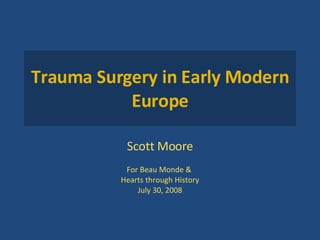
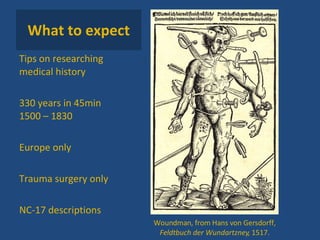
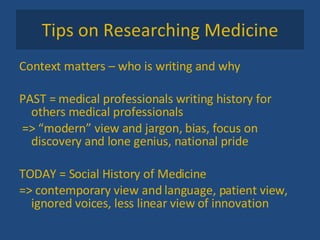
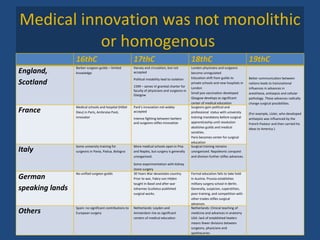
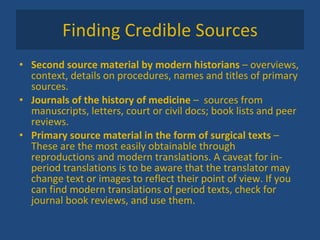

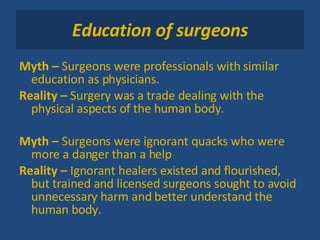
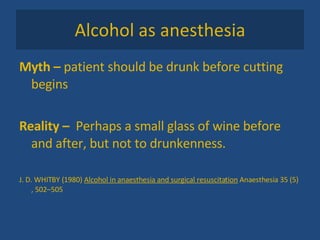
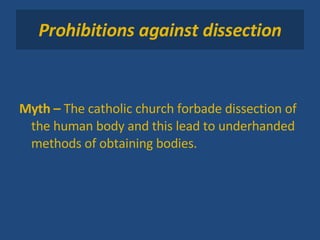
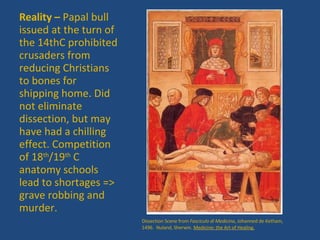
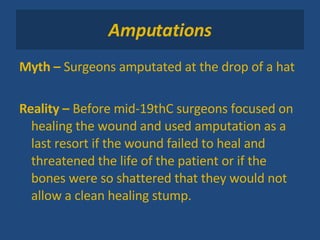
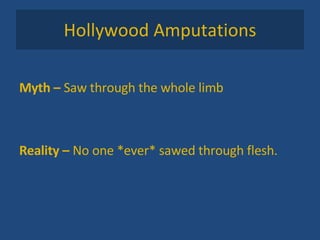
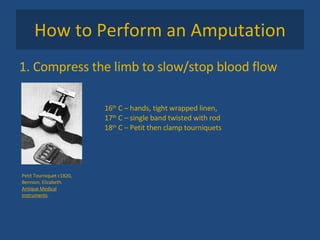
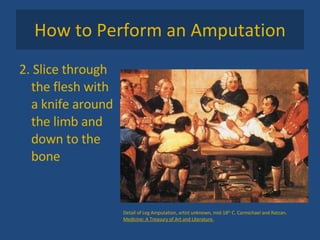
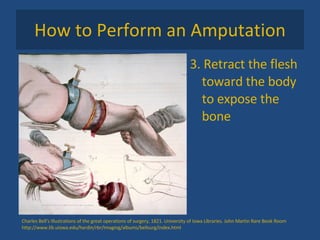

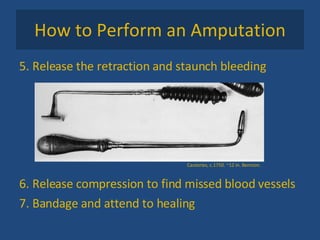

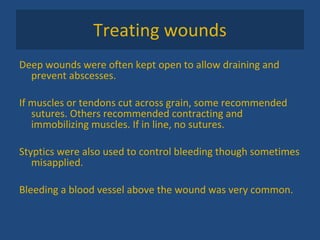
![Many styles of sutures Adhesive cloth and suture for facial cuts. Ambroise Pare. Three and Fifty Instruments of Chirurgery. 1631. Sample sutures, ca 18thC Medizinhistorisches Museum of the University of Zurich http://www.mhiz.unizh.ch/ Hannah Blair, Photographer http://www.flickr.com/photos/hannahmae/ [Various types of suture techniques and instruments] / J.M.B. sc. 1734 Images from the History of Medicine at the U.S. National Library of Medicine http://wwwihm.nlm.nih.gov](https://image.slidesharecdn.com/2008-surgery-workshop-1217981088867150-8/85/Trauma-Surgery-in-Early-Modern-Europe-20-320.jpg)
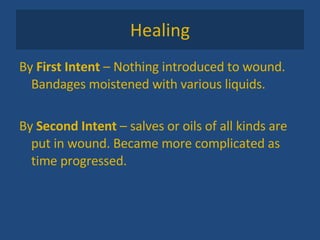
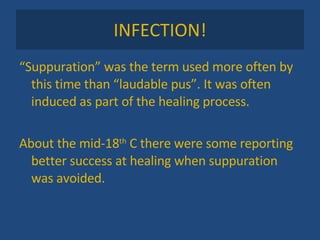
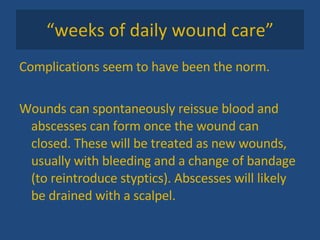
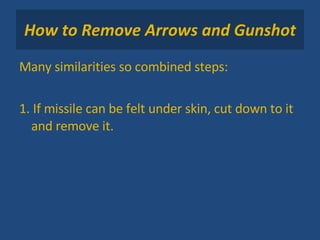
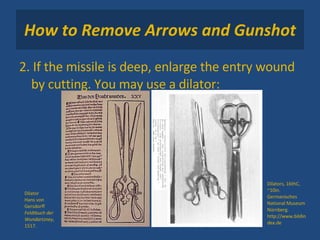


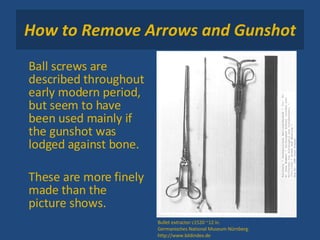
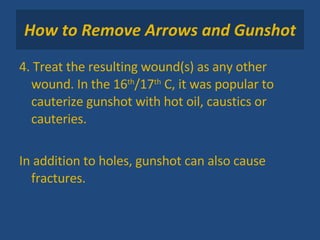
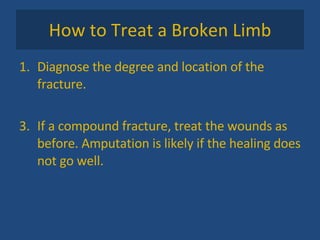
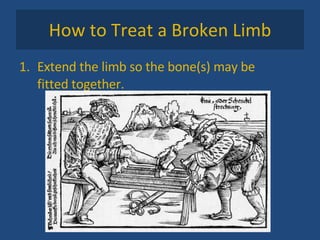
![How to Treat a Broken Limb Bind the limb tightly. [Fractured arm and Simple fracture] / Arnold Delineavit. 1666 in Armamentarium chirurgicum by Johannes Scultetus Images from the History of Medicine at the U.S. National Library of Medicine http://wwwihm.nlm.nih.gov](https://image.slidesharecdn.com/2008-surgery-workshop-1217981088867150-8/85/Trauma-Surgery-in-Early-Modern-Europe-32-320.jpg)
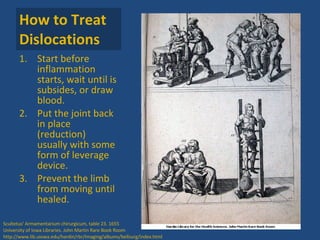
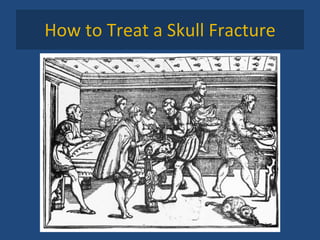
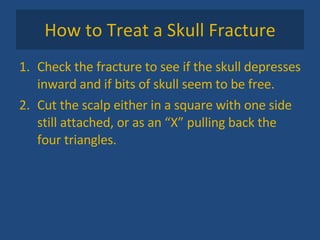

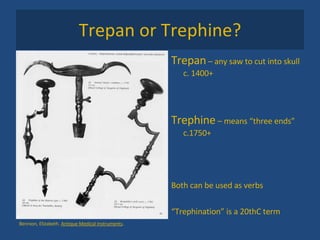

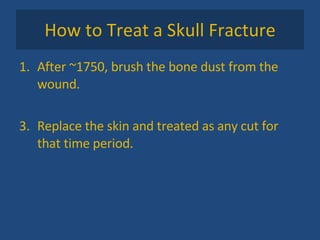

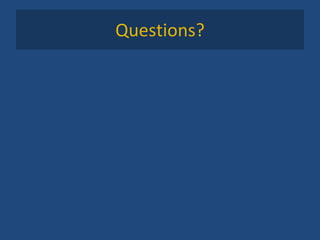
![Thank You! ║▌║▌▀Żs, updated handout, timeline, books [email_address] Comments, critiques, suggestions welcomed.](https://image.slidesharecdn.com/2008-surgery-workshop-1217981088867150-8/85/Trauma-Surgery-in-Early-Modern-Europe-42-320.jpg)